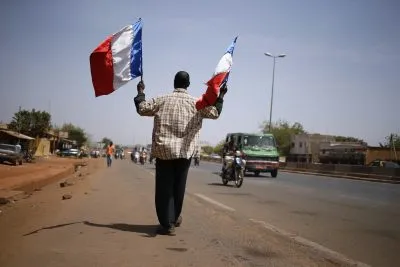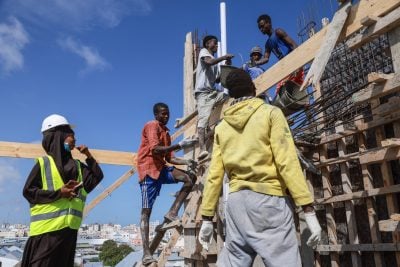Africa is on an economic, political and social high as never before and the projections are for a better tomorrow than today. But what if things turn topsy-turvy? What if commodity prices crash or China goes down the pan? Richard Walker assesses the black swans that could derail Africa’s growth and suggests ways to avoid it.
Africa is heading for a crash. It might be a few years down the line. It might be just around the corner. The only thing that is sure is that when it comes – if it comes – it will be very, very big. Big enough to wreck Africa’s hopes of prosperity and democracy. But this is a crash that doesn’t actually have to happen. If Africa’s business leaders and policy makers see the threats that are gathering on the near horizon, and act on them, then this will be the disaster that wasn’t. But now is not the time to get complacent. It has happened before, and it can happen again. But why the talk of crashes and meltdowns, when the majority of Africa’s economies are in better shape than they have been for decades? Africa is on a roll, and everyone knows it.
With the global economy recording growth levels that are close to a historic low, with large swathes of the industrialised world at or near recession levels, Africa is now the second–fastest-growing regional economy (after developing Asia) and has the capacity to soon become the fastest-growing region. If you want growth, dynamism and innovation, Africa is the place to find it. Africa has never had it so good, and sub-Saharan Africa has it best of all. What on earth could go wrong? Unfortunately, the answer is: plenty. Last year I wrote an analysis of Africa’s prospects for the emerging markets investment bank Renaissance Capital, or RenCap.
Published as the concluding chapter of RenCap’s book The Fastest Billion, it outlined all that was good about Africa’s rush for growth and democratisation. Africa’s time is now, the book concluded – and it was right. But readers and critics missed something else that was also in our book. Africa’s time is indeed now – the mix of reform and wealth creation, demographics and technology, plus very high commodity prices and very low debt all make Africa the region of choice for investors and businesses looking for the next big global growth story.
But what is true today may not be true tomorrow. We live in a fast-changing world; conditions can change rapidly and perceptions can change even faster. The capital-rich fund managers and business leaders who are knocking urgently on African doors today could be on their planes back home tomorrow.
It all depends on how Africa itself manages the moment. Conditions are looking exceptionally positive – today. But there have been great cycles of hope and expectation before – amid the political reforms of the 1950s and 1960s, amid the commodity boom of the 1970s and early 1980s, as well as the second commodity boom and the technology revolution of the last decade.
Today Africa is experiencing another high point of hope and expectation. And things are changing for the better, in most (although not all) of Africa’s states. Incomes and living standards are rising. Healthcare levels have improved out of all recognition. Advanced communications technology is in the pockets of even the poorest. Democracy is spreading, corruption is falling, and while the autocratic old guard have not disappeared, at least they are in retreat. But history suggests that when expectations are running high, the danger of disappointment is also high.
How to identify danger points
And it is not difficult to identify where the African danger points lie. The first thing to say is: they are not primarily political. Politicians may not want to hear it, but the fact is that over the long term, politics dances to the tune the economy plays.
Everywhere in the world, democratisation is linked to per capita income levels. When countries enter the income band that is roughly $6,000 to $10,000 per capita income, they become very likely to turn into real democracies, if they have not done so already. Once they achieve over $10,000 a year, they are near certain to democratise and stay that way. There has never been a case of a country with per capita income levels permanently over that level that has abandoned democracy. The only exceptions are oil-based autocracies or ‘managed democracies’, where the income is not distributed, the middle class is weak, and where the call for reform is weak too. So the danger points lie elsewhere. Actually there are plenty, but the biggest are these: commodities, infrastructure and China. Each is a factor in Africa’s current upbeat story. Each contains a seed capable of growing into massive disappointment.
The commodity economy is the engine of Africa’s current economic upturn. From copper to cobalt, from aluminium to iron, from gold to platinum to diamonds – and lots of oil. The cycle of rising commodity prices that began a decade and a half ago and continues today has brought a massive inflow of wealth to private businesses and to official treasuries. It has been a vital factor in Africa’s extraordinary success in reducing domestic budget deficits, to the point where the region as a whole ran a budget surplus for five years from 2004. The Global Financial Crisis pushed budgets back into a 5% deficit in 2009, but the region succeeded in reducing the deficit to close to zero last year. No other region of the world has managed such a dramatic improvement in public finances against such a tough economic background. And it is hard commodity cash that has allowed it to happen.
High commodity prices have always coincided with periods of optimism and broader economic growth in Africa – so much so that one must conclude that it is not in fact a coincidence. But in the past, the cycle has always turned. High prices are followed by a deep slump – as happened in the mid-1980s. Copper mines lie abandoned. Aluminium smelters are mothballed. Exploration and development programmes screech to a halt. And as tax receipts fall, government debt levels start to rise, inexorably. Some economists believe that won’t happen. They believe that the world is still in what they call a ‘supercycle’ of rapid development and high commodity demand, driven by the emergence of India, China, the rest of developing Asia and indeed Africa itself. All these emerging economies need massive supplies of minerals and metals, as well as energy, food, and industrial raw materials. After all, the Global Financial Crisis has not succeeded in ending the commodity boom yet. True – but even though they are very volatile in the short term, average commodity prices tend to move quite slowly, so continuing strong prices may not be as significant as they seem.
The long investment cycles needed to develop new mines and processing facilities mean that production can come on stream long after the peak of prices has passed. Right now, the world probably has a surplus of production in many key industrial commodities, including iron and copper, and in precious metals like gold and platinum. It is not true to say that commodity prices are still at their peak. Almost across the board, they have plateaued and then declined somewhat. Demand from China is what is keeping them as high as they are – and as we will see, demand from China is far from assured.
Misplaced optimism?
So, the commodity boom has been wonderful for Africa. Prices remain good – and much, much better in real terms than they were in the late 1980s and early 1990s. The result is optimism – an optimism that may be seriously misplaced. Don’t rule out a commodity price crash that could turn Africa’s economic prospects upside-down.
Infrastructure is the next pressure point. The story of African infrastructure is a story that could turn from opportunity to crisis due to little more than a change of mood. For investors, every lack is an opportunity. If there is a need for infrastructure – and Africa’s need is massive – then the optimistic investor sees the opportunity to profit from what should be the world’s biggest construction boom ever, bigger even than China’s.
But investment need is one thing: fulfilling it is another. For example, take the road network – or lack of it. After more than half a century of political independence, Africa has still not managed to create a transcontinental highway. To do so it will have to build somewhere between 60,000 and 100,000 km of high-quality roads. Or take power: the lack of reliable electrical power from national grids remains one of the biggest drags on economic growth in the region (many businesses cite it as their top concern).
Nigeria alone is spending more than $10bn a year importing standalone generator sets which have become its main (and very expensive) source of electricity. Meanwhile, the national grid in this richest of oil-rich African countries still only manages to produce enough electricity to run one refrigerator for one in every 30 citizens. The World Bank estimates sub-Saharan Africa would have to spend $40bn a year on power generation alone to catch up with the developing economy average – and that is more than the whole of the region currently receives in total foreign direct investment ($36.9bn, according to UNCTAD figures). In other words, nobody knows where the money will come from to fund Africa’s infrastructure bill. Foreign direct investment has recovered since the Global Financial Crisis, but it has not exceeded its 2008 peak, and at current levels is nowhere near meeting the need.
Of course, domestic capital sources should also be part of the infrastructure story. But for that to happen there will need to be a change of mindset: Africa will have to stop treating infrastructure as a resource to be consumed, and start treating it as an investment to be managed. It’s the shift from a donor to an investor mindset, and it hasn’t happened yet. For example, Africa spends less than 2% of GDP on road network maintenance, while the developing economy average is 3% (and excluding Africa it is higher): that means Africa is under-maintaining its infrastructure, making what should be an investment opportunity look more like an investment risk. The message to policy makers is simple. Start to fix infrastructure now: if you don’t, your promises of future growth will crumble alongside your roads and bridges.
And then there is China. For Africa, China is a double-edged sword. Chinese participation in Africa’s economy has been extraordinarily positive. China has proved the kind of partner that Africa can work with – superpower investments, without superpower terms and conditions. But after three decades of relentlessly rising investment levels, Africa’s dependence on China is beginning to look like a risk. Because China is in trouble.
When China sneezes…
The Chinese have been exporting manufactures, building roads and giving aid to Africa for decades. But the relationship has changed. China is now Africa’s biggest investor, and in 2012 it became Africa’s biggest foreign market. According to a new database from AidData, China put a total of $260bn into Africa between 2000 and 2011 in investment and aid combined. In 2011 alone (the last full year for which there are figures), the total was over $34bn – far larger than previously thought. That means that it is likely that China accounts for a clear majority of the total FDI going to the region. In investment terms, that is known as concentration risk: it means that when China sneezes, Africa catches cold.
Africa is also increasingly reliant on China for export revenues. China-bound exports have increased from $2bn in 2008 to $5bn today, more than half of one per cent of total regional GDP. According to research specialist Capital Economics, certain sub-Saharan countries are particularly exposed to the risk of a downturn in Chinese export demand, including Botswana, Angola and Zambia. Will there be a downturn in Chinese demand and Chinese investment? China has been growing at 10-12% or more (no one is really sure) for most of the last 15 years. It has seen an explosion in domestic investment, a property bubble, and huge growth in the loan books of the banking sector, much of which is informal and unregulated. There has never in history been a boom on this scale without a subsequent bust. Chinese growth is already tracking downwards (at around 7% it could already be half of peak growth levels in the last decade) and could go much, much lower. The message is clear to read: prepare for a Chinese ‘hard landing’ now – by diversifying exports, diversifying investment sources, and especially by making sure there is enough surplus in domestic budgets to cover the emergency spending necessary to fill the demand gap when the Chinese economy nosedives. It may not happen – but it probably will.
Pressure points
These are the key pressure points for sub-Saharan Africa’s economies: the pressure points that could strangle growth and precipitate a crash. They are not the only ones – education, healthcare, business environment reform and still better communications, all are almost as important. But commodities, heavy infrastructure and the China dimension are the triumvirate of big risk factors. What happens if the risks are not addressed? Simple: Africa can say goodbye to 6% growth, year-on-year FDI increases, and any talk of Africa being the next big thing. One of Africa’s biggest assets is its youth. Young populations are usually associated with rapid economic growth, and Africa has the best demographic profile of any region until at least 2050, with more working age adults as a proportion of the population than South America, China or India. In a world of wellmanaged risks that is good. But in the world of the big African crash, when the risks outrun the opportunities, it is no longer good. There will be a lot of angry young people on the streets. Or as someone said, things may just fall apart. The time to take measures to prevent this happening is now – while the going is still good.
Want to continue reading? Subscribe today.
You've read all your free articles for this month! Subscribe now to enjoy full access to our content.
Digital Monthly
£8.00 / month
Receive full unlimited access to our articles, opinions, podcasts and more.
Digital Yearly
£70.00 / year
Our best value offer - save £26 and gain access to all of our digital content for an entire year!
 Sign in with Google
Sign in with Google 


